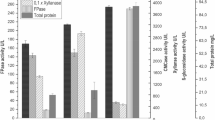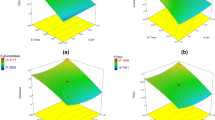Abstract
Purpose
In this study, a combinatory approach was undertaken to assay the efficiency of fungal enzymatic cocktails from different fermentation conditions to degrade different lignocellulosic biomasses with the aim of finely characterizing fungal enzymatic cocktails.
Methods
Enzymatic assays (AZO and pNP-linked substrates and ABTS) were used to assess the composition of the fungal enzymatic cocktails for cellulase, xylanase and laccase activities. Comparisons were made with a new range of chromogenic substrates based on complex biomass (CBS substrates). The saccharification efficiency of the cocktails was evaluated as a quantification of the sugar monomers released from the different biomasses after incubation with the enzymatic cocktails.
Results
The results obtained showed striking differences between the AZO and pNP-linked substrates and the CBS substrates for the same enzymatic cocktails. On AZO and pNP-linked substrates, different hydrolysis profiles were observed between the different fungi species with Aspergillus oryzae being the most efficient. However, the results on CBS substrates were more contrasted depending on the biomass tested. Altogether, the results highlighted that assessing laccase activities and taking into account the complexity of the biomass to degrade were key in order to provide the best enzymatic cocktails.
Conclusion
The complementary experiments performed in this study showed that different approaches needed to be taken in order to accurately assess the ability of an enzymatic cocktail to be efficient when it comes to lignocellulosic biomass degradation. The saccharification assay proved to be essential to validate the data obtained from both simple and complex substrates.





source as a measure of Carbon Catabolite Repression. Results are displayed as absorbances ± the standard deviation around the mean of three biological replicates



Similar content being viewed by others
References
Álvarez C, Reyes-Sosa FM, Díez B (2016) Enzymatic hydrolysis of biomass from wood. Microb Biotechnol 9:149–156
Banerjee G, Scott-Craig JS, Walton JD (2010) Improving enzymes for biomass conversion: a basic research perspective. Bioenergy Res 3:82–92
Canilha, L., Chandel, A.K., Suzane dos Santos Milessi, T., Antunes, F.A.F., Luiz da Costa Freitas, W., das Graças Almeida Felipe, M., da Silva, S.S. (2012) Bioconversion of sugarcane biomass into ethanol: an overview about composition, pretreatment methods, detoxification of hydrolysates, enzymatic saccharification, and ethanol fermentation. J Biomed Biotechnol. 2012, 1–15
Carapito R, Carapito C, Jeltsch J-M, Phalip V (2009) Efficient hydrolysis of hemicellulose by a Fusarium graminearum xylanase blend produced at high levels in Escherichia coli. Bioresour Technol 100:845–850
Chandra RP, Bura R, Mabee WE, Berlin A, Pan X, Saddler JN (2007) Substrate pretreatment: the key to effective enzymatic hydrolysis of lignocellulosics? In: Olsson L (ed) Biofuels. Springer Berlin Heidelberg, Berlin, Heidelberg, pp 67–93
de Vries RP, Visser J (2001) Aspergillus enzymes involved in degradation of plant cell wall polysaccharides. Microbiol Mol Biol Rev 65:497–522
Debeire P, Delalande F, Habrylo O, Jeltsch J-M, Van Dorsselaer A, Phalip V (2014) Enzymatic cocktails produced by Fusarium graminearum under submerged fermentation using different lignocellulosic biomasses. FEMS Microbiol Lett 355:116–123
Dence CW (1992) The determination of lignin. In: Lin SY, Dence CW (eds) Methods in lignin chemistry springer series in wood science. Springer Berlin Heidelberg, Berlin, Heidelberg, pp 33–61
Fang H, Deng J, Zhang X (2011) Continuous steam explosion of wheat straw by high pressure mechanical refining system to produce sugars for bioconversion. BioResources 6(4):4468–4480
Galhaup C, Wagner H, Hinterstoisser B, Haltrich D (2002) Increased production of laccase by the wood-degrading basidiomycete Trametes pubescens. Enzyme Microb Technol 30:529–536
Gonçalves GAL, Takasugi Y, Jia L, Mori Y, Noda S, Tanaka T et al (2015) Synergistic effect and application of xylanases as accessory enzymes to enhance the hydrolysis of pretreated bagasse. Enzyme Microb Technol 72:16–24
Gottschalk LMF, Oliveira RA, da Bon Silva EP (2010) Cellulases, xylanases, β-glucosidase and ferulic acid esterase produced by Trichoderma and Aspergillus act synergistically in the hydrolysis of sugarcane bagasse. Biochem Eng J 51:72–78
Jia L, Sun Z, Ge X, Xin D, Zhang J (2013) Comparison of the delignifiability and hydrolysability of wheat straw and corn stover in aqueous ammonia pretreatment. BioResources 8:4505–4517
Jing Y, Dong L, Guo Y, Liu X, Wang Y (2020) Chemicals from lignin: a review of catalytic conversion involving hydrogen. Chemsuschem 13:4181–4198
Kračun SK, Schückel J, Westereng B, Thygesen LG, Monrad RN, Eijsink VGH, Willats WGT (2015) A new generation of versatile chromogenic substrates for high-throughput analysis of biomass-degrading enzymes. Biotechnol Biofuels 8:70
Kubicek CP, Mikus M, Schuster A, Schmoll M, Seiboth B (2009) Metabolic engineering strategies for the improvement of cellulase production by Hypocrea jecorina. Biotechnol Biofuels 2:19
Lee SY, Kim HU, Chae TU, Cho JS, Kim JW, Shin JH et al (2019) A comprehensive metabolic map for production of bio-based chemicals. Nat Catal 2:18–33
Liu C, van der Heide E, Wang H, Li B, Yu G, Mu X (2013) Alkaline twin-screw extrusion pretreatment for fermentable sugar production. Biotechnol Biofuels 6:97
Lu Y, Yang B, Gregg D, Saddler JN, Mansfield SD (2002) Cellulase adsorption and an evaluation of enzyme recycle during hydrolysis of steam-exploded softwood residues. Appl Biochem Biotechnol 98–100:641–654
Martinez D, Berka RM, Henrissat B, Saloheimo M, Arvas M, Baker SE et al (2008) Genome sequencing and analysis of the biomass-degrading fungus Trichoderma reesei (syn. Hypocrea jecorina). Nat Biotechnol 26:553–560
Menon V, Rao M (2012) Trends in bioconversion of lignocellulose: biofuels, platform chemicals and biorefinery concept. Progress Energy Combust Sci 38:522–550
Meyer AS, Rosgaard L, Sørensen HR (2009) The minimal enzyme cocktail concept for biomass processing. J Cereal Sci 50:337–344
Mezule L, Civzele A (2020) Bioprospecting white-rot basidiomycete Irpex lacteus for improved extraction of lignocellulose-degrading enzymes and their further application. J Fungi 6:256
Mitchell DB, Vogel K, Weimann BJ, Pasamontes L, van Loon APGM (1997) The phytase subfamily of histidine acid phosphatases: isolation of genes for two novel phytases from the fungi Aspergillus terreus and Myceliophthora thermophila. Microbiology 143:245–252
Nakagame S, Chandra RP, Saddler JN (2010) The effect of isolated lignins, obtained from a range of pretreated lignocellulosic substrates, on enzymatic hydrolysis. Biotechnol. Bioeng. n/a-n/a.
Pan X, Xie D, Gilkes N, Gregg DJ, Saddler JN (2005) Strategies to enhance the enzymatic hydrolysis of pretreated softwood with high residual lignin content. Appl Biochem Biotechnol 124:1069–1080
Peciulyte A, Pisano M, de Vries RP, Olsson L (2017) Hydrolytic potential of five fungal supernatants to enhance a commercial enzyme cocktail. Biotechnol Lett 39:1403–1411
Periasamy R, Palvannan T (2010) Optimization of laccase production by Pleurotus ostreatus IMI 395545 using the Taguchi DOE methodology. J Basic Microbiol 50:548–556
Phalip V, Delalande F, Carapito C, Goubet F, Hatsch D, Leize-Wagner E et al (2005) Diversity of the exoproteome of Fusarium graminearum grown on plant cell wall. Curr Genet 48:366–379
Pryor SW, Nahar N (2015) β-glucosidase supplementation during biomass hydrolysis: how low can we go? Biomass Bioenergy 80:298–302
Raulo R, Heuson E, Siah A, Phalip V, Froidevaux R (2019) Innovative microscale workflow from fungi cultures to cell wall-degrading enzyme screening. Microb Biotechnol 12:1286–1292
Ulber R, Sell D (eds) (2007W) White biotechnology. Springer Berlin Heidelberg, Berlin, Heidelberg
Van Dyk JS, Pletschke BI (2012) A review of lignocellulose bioconversion using enzymatic hydrolysis and synergistic cooperation between enzymes-factors affecting enzymes, conversion and synergy. Biotechnol Adv 30:1458-1480
Várnai A, Siika-aho M, Viikari L (2010) Restriction of the enzymatic hydrolysis of steam-pretreated spruce by lignin and hemicellulose. Enzyme Microb Technol 46:185–193
Walker S, Jaime R, Kagot V, Probst C (2018) Comparative effects of hermetic and traditional storage devices on maize grain: mycotoxin development, insect infestation and grain quality. J Stored Prod Res 77:34–44
Zeng Y, Himmel ME, Ding S-Y (2017) Visualizing chemical functionality in plant cell walls. Biotechnol Biofuels 10:263
Acknowledgements
This work was supported by the Alibiotech project that is financed by the European Union, the French State and the French Region of Hauts-de-France. The REALCAT platform is benefiting from a Governmental subvention administrated by the French National Research Agency (ANR) within the frame of the ‘Future Investments’ program (PIA), with the contractual reference ‘ANR-11-EQPX-0037’. The Hauts-de-France Region and the FEDER as well as the Centrale Innovation Fondation are thanked for their financial contribution to the acquisition of the equipment of the platform.
Funding
This study were funded by région hauts-de-france, feder and centrale innovation fondation.
Author information
Authors and Affiliations
Corresponding author
Additional information
Publisher's Note
Springer Nature remains neutral with regard to jurisdictional claims in published maps and institutional affiliations.
Rights and permissions
About this article
Cite this article
Raulo, R., Heuson, E., Froidevaux, R. et al. Combining analytical approaches for better lignocellulosic biomass degradation: a way of improving fungal enzymatic cocktails?. Biotechnol Lett 43, 2283–2298 (2021). https://doi.org/10.1007/s10529-021-03201-2
Received:
Accepted:
Published:
Issue Date:
DOI: https://doi.org/10.1007/s10529-021-03201-2




